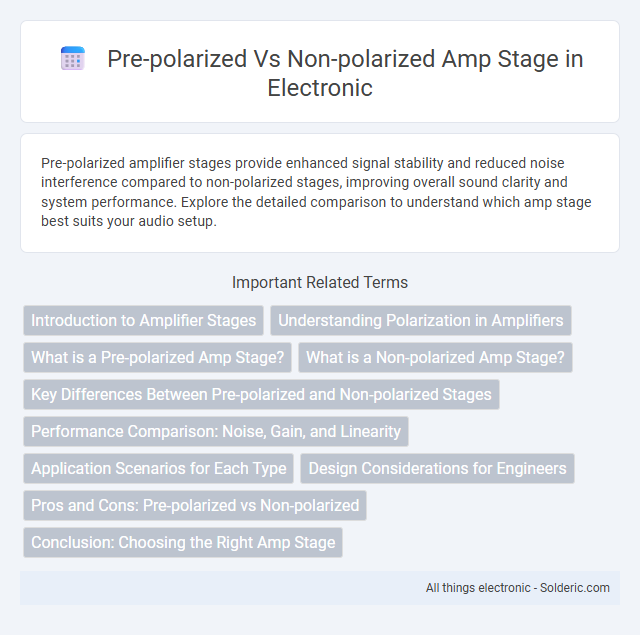Pre-polarized amplifier stages provide enhanced signal stability and reduced noise interference compared to non-polarized stages, improving overall sound clarity and system performance. Explore the detailed comparison to understand which amp stage best suits your audio setup.
Comparison Table
| Feature | Pre-polarized Amp Stage | Non-polarized Amp Stage |
|---|---|---|
| Biasing | Uses a built-in bias voltage for stable operation | Requires external biasing or feedback network |
| Noise Performance | Generally lower noise due to stable biasing | Higher noise levels due to lack of bias stabilization |
| Complexity | Simpler design, fewer external components | More complex, needs additional components for biasing |
| Power Consumption | Typically optimized for lower power consumption | Variable power consumption based on external biasing |
| Frequency Response | Stable frequency response due to preset bias | Frequency response can vary with bias conditions |
| Application | Ideal for precision, low-noise amplification | Used in flexible designs requiring adjustable bias |
Introduction to Amplifier Stages
Amplifier stages differentiate primarily by their biasing methods, with pre-polarized stages incorporating internal bias voltages to set the operating point, enhancing stability and linearity. Non-polarized stages require external biasing, offering flexibility but demanding precise calibration to avoid distortion and ensure optimal performance. Understanding these distinctions is crucial for designing efficient amplifier circuits tailored to specific audio or signal processing applications.
Understanding Polarization in Amplifiers
Polarization in amplifiers refers to the DC biasing of the transistor or tube within the amplifier stage, which affects its linearity and efficiency. Pre-polarized amplifier stages incorporate a built-in bias, ensuring stable operating points without external adjustment, while non-polarized stages require manual biasing for optimal performance. Understanding these differences helps you choose the right amplifier configuration to match your signal fidelity and power requirements.
What is a Pre-polarized Amp Stage?
A pre-polarized amp stage is an amplifier configuration where the input transistor is set with a fixed DC bias voltage to stabilize operation and optimize signal linearity. This biasing ensures consistent input impedance and minimizes distortion compared to non-polarized stages. Non-polarized amp stages lack this predetermined bias, resulting in higher variability and potentially reduced performance in audio frequency response and noise handling.
What is a Non-polarized Amp Stage?
A non-polarized amp stage uses capacitors and resistors without a fixed voltage polarity, enabling AC signal amplification without distortion caused by polarized components. This design allows for more flexibility in signal processing and is often preferred in applications where the input signal varies above and below ground potential. Understanding your circuit's requirements will help determine if a non-polarized amp stage is the optimal choice.
Key Differences Between Pre-polarized and Non-polarized Stages
Pre-polarized amplifier stages feature built-in biasing that stabilizes transistor operation, improving signal linearity and reducing distortion, while non-polarized stages require external bias setup, offering more flexibility but demanding precise adjustments. The pre-polarized design enhances consistency across varying temperatures and device tolerances, making it ideal for high-fidelity audio applications. Your choice between these stages impacts the amplifier's stability, complexity, and performance accuracy.
Performance Comparison: Noise, Gain, and Linearity
Pre-polarized amplifier stages typically exhibit lower noise levels and improved gain stability compared to non-polarized stages, enhancing overall signal clarity. Your audio system's linearity benefits from pre-polarized designs due to reduced distortion and consistent performance across varying input levels. Non-polarized stages may offer simpler construction but often sacrifice noise performance and linearity under demanding conditions.
Application Scenarios for Each Type
Pre-polarized amplifier stages are ideal for high-frequency applications and low-noise environments such as RF receivers and communication devices where stable biasing ensures consistent performance. Non-polarized amplifier stages suit general-purpose amplification in audio equipment and signal processing systems where flexibility and simplicity in design are prioritized. Selecting between pre-polarized and non-polarized amp stages depends on specific requirements for noise sensitivity, frequency response, and circuit complexity in targeted application scenarios.
Design Considerations for Engineers
Designing pre-polarized amplifier stages requires careful biasing to stabilize operating points and minimize noise, enhancing signal integrity in low-level audio applications. Engineers must optimize resistor values and capacitor placements to ensure linearity and reduce distortion in non-polarized amplifier stages, emphasizing component matching for balanced performance. Thermal stability and frequency response are critical factors influencing the choice between pre-polarized and non-polarized designs in precision analog circuitry.
Pros and Cons: Pre-polarized vs Non-polarized
Pre-polarized amplifier stages offer improved signal linearity and lower noise levels, enhancing audio clarity, while non-polarized stages provide greater flexibility in handling AC signals and simpler circuit design. Pre-polarized types can be more complex and expensive due to the need for biasing components, whereas non-polarized stages might introduce distortion or reduced fidelity under certain conditions. Choosing your amplifier stage depends on balancing performance requirements with design complexity and cost constraints.
Conclusion: Choosing the Right Amp Stage
Choosing the right amp stage depends on application-specific requirements such as noise tolerance, signal clarity, and power consumption. Pre-polarized amp stages offer improved noise performance and stability, making them ideal for precision instrumentation and sensitive audio equipment. Non-polarized amp stages excel in versatility and simplicity, often preferred in general-purpose amplification where cost and design flexibility are priorities.
Pre-polarized vs Non-polarized amp stage Infographic

 solderic.com
solderic.com